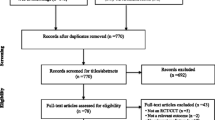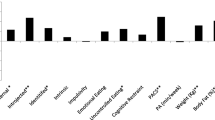Abstract
This study was designed to examine the factors predicting a range of body change strategies among adolescent males over an 8-month time period. This is the first published longitudinal study of body change strategies to increase weight and muscles among males. The 5 body change strategies in the present study were eating and exercise to lose weight, increase weight, increase muscles, bingeing, and use of food supplements. The extent to which Body Mass Index (BMI) and these body change strategies predicted each other over an 8-month period was evaluated. The role of pressure from parents and peers to lose weight, increase weight, or increase muscles was also evaluated. After controlling for the Time 1 level of each variable, only bingeing, and use of food supplements were predicted by other Time 1 body change variables. Bingeing at Time 1, and a combination of all of the other variables predicted bingeing at Time 2; use of food supplements and bingeing at Time 1 predicted the use of food supplements at Time 2. Perceived pressure from parents and peers to lose weight at Time 1 predicted strategies to lose weight at Time 2; perceived pressure from parents and peers to increase weight at Time 1 predicted strategies to increase weight at Time 2; and perceived pressure to lose weight, increase weight, and increase muscles at Time 1 predicted the use of food supplements at Time 2. These results indicate that extreme body change strategies are predicted by the adoption of more normative body change strategies at an earlier point in time, and that a range of body change strategies among adolescent males are affected by perceived pressures from parents and peers.
Similar content being viewed by others
REFERENCES
Connan, F. (1998). Machismo nervosa: An ominous variant of bulimia nervosa? Eur. Eat. Disord. Rev. 6: 154–159.
Drewnowski, A., Kurth, C. L., and Krahn, D. D. (1995). Effects of body image on dieting, exercise, and anabolic steroid use in adolescent males. Int. J. Eat. Disord. 17: 381–386.
Field, A. E., Camargo, C. A., Barr Taylor, C., Berkey, C. S., Frazier, A. L., Gillman, M. W., and Colditz, G. A. (1999). Overweight, weight concerns, and bulimic behaviors among girls and boys. Am. Acad. Child Adolesc. Psychiatry. 38: 754–760.
Furnham, A., and Calnan, A. (1998). Eating disturbance, self-esteem, reasons for exercising and body weight dissatisfaction in adolescent males. Eur. Eat. Disord. Rev. 6: 58–72.
Keel, P. K., Fulkerson, J. A., and Leon, G. R. (1997). Disordered eating percursors in pre-and early adolescent girls and boys. J. Youth Adolesc. 26: 203–216.
Komoroski, E. V., and Rickert, V. I. (1992). Adolescent body image and attitudes to anabolic steroid use. Sports Med. 146: 823–828.
Leon, G. R., Fulkerson, J. A., Perry, C. L., Keel, P. K., and Klump, K. L. (1999). Three to four year prospective evaluation of personality and behavioral risk factors for later disordered eating in adolescent girls and boys. J. Youth Adolesc. 28: 181–196.
McCabe, M. P., and Ricciardelli, L. A. (2001a). Body image and body change techniques among young adolescent boys. Eur. Eat. Disord. Rev. 9: 335–347.
McCabe, M. P., and Ricciardelli, L. A. (2001b). Parent, peer and media influences on body image and strategies to both increase and decrease body size among adolescent boys and girls. Adolescence 36: 225–240.
McCabe, M. P., and Ricciardelli, L. A. (2001c). The structure of the Perceived Sociocultural Influences on Body Image and Body Change Questionnaire. Int. J. Behav. Med. 8: 19–41.
McCabe, M. P., and Ricciardelli, L. A. (in press). Sociocultural influences on body image and body change strategies among adolescent boys and girls. J. Soc. Psychol.
McCabe, M. P., Ricciardelli, L. A., and Finemore, J. (in press). The role of puberty, media and popularity with peers on strategies to increase weight, decrease weight and increase muscle tone among adolescent boys and girls. J. Psychosom. Res.
McCabe, M. P., and Vincent, M. A. (2002). Development and validation of Body Modification Scales and Excessive Exercise Scales for adolescents. Assessment 9: 131–141.
McCabe, M. P., and Vincent, M. A. (in press). The role of biodevelopmental and psychological factors in disordered eating in adolescents. Eur. Eat. Disord. Rev.
McCreary, D. R., and Sasse, D. K. (2000). An exploration of the drive for muscularity in adolescent boys and girls. J. Am. Coll. Health 48: 297–304.
Moore, D. C. (1990). Body image and eating behavior in adolescent boys. Am. J. Dis. Child. 144: 475–479.
Neumark-Sztainer, B., Sherwood, N.W., French, S.A., and Jeffery, R.W. (1999). Weight control behaviors among adult men and women: Cause for concern? Obes. Res. 7: 179–188.
Olivardia, R., Pope, H. G., Mangweth, B., and Hudson, J. I. (1995). Eating disorders in college men. Am. J. Psychiatry 152: 1279–1285.
Pope, H. G., Olivardia, R., Gruber, A., and Barowiecki, J. (1999). Evolving ideals of male body image as seen through action toys. Int. J. Eat. Disord. 26: 65–72.
Ricciardelli, L. A., and McCabe, M. P. (2002). Psychometric evaluation of the Body Change Inventory: An assessment instrument for adolescent boys and girls. Eat. Behav. 2: 1–15.
Ricciardelli, L. A., McCabe, M. P., and Banfield, S. (2000). Body image and body change methods in adolescent boys: Role of parents, friends and the media. J. Psychosom. Res. 48: 189–197.
Striegel-Moore, R. H., and Kearney-Cooke, A. (1994). Exploring parents' attitudes and behaviors about their children's physical appearance. Int. J. Eat. Disord. 15: 377–385.
Wichstrom, L. (2000). Psychological and behavioral factors unpredictive of disordered eating: A prospective study of the general adolescent population in Norway. Int. J. Eat. Disord. 28: 33–42.
Wichstrom, L., and Petersen, W. (2001). Use of anabolic-androgenic steroids in adolescence: Winning, looking good or being bad? J. Stud. Alcohol 62: 5–13.
Wroblewska, A. M. (1997). Androgenic-anabolic steroids and body dysmorphia in young men. J. Psychosom. Res. 42: 225–234.
Author information
Authors and Affiliations
Rights and permissions
About this article
Cite this article
McCabe, M.P., Ricciardelli, L.A. A Longitudinal Study of Body Change Strategies Among Adolescent Males. Journal of Youth and Adolescence 32, 105–113 (2003). https://doi.org/10.1023/A:1021805717484
Issue Date:
DOI: https://doi.org/10.1023/A:1021805717484




